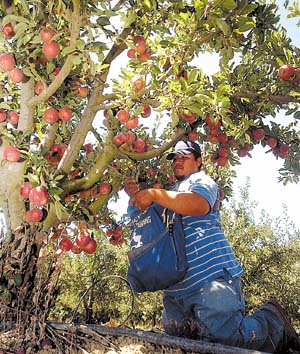The county’s apple harvest began this week, with apples of
decent size but a crop not as plentiful as in previous years, local
growers reported.
Hollister – The county’s apple harvest began this week, with apples of decent size but a crop not as plentiful as in previous years, local growers reported.
B&P Orchards co-owner Anthony Botelho’s crews began picking the red delicious variety Monday, the first of five varieties to be released for harvest in San Benito County.
“This year, all in all, has had pretty good growing weather for apples,” Botelho said. In 2006, erratic weather caused a late apple harvest.
Many hours of cold winter weather helped the trees stay hibernating, Botelho said. Growers would have appreciated a wetter spring, but a mild summer didn’t stress the fruit as it did in 2006, Botelho said.
This harvest will be about average, Botelho said.
And as apple trees are ripped from the soil through the county and replaced with more manageable row crops, the fruit’s total yield will continue to drop, said San Benito County Agricultural Commissioner Paul Matulich.
“The apple is slowly disappearing,” Matulich said. “The prunes disappeared, the pear disappeared. They had some beautiful orchards and they grew some beautiful fruit, but they just couldn’t compete with the other areas.”
Rising water levels in the San Juan Valley – from the import of water from the San Felipe Project – has been drowning some of the apple orchards.
“It’s a problem growing orchards in San Juan Valley now,” Botelho said.
About 90 percent of the county’s apple crop grows in the San Juan Valley, Matulich estimated.
In 1996, there were 568 acres of apple trees in San Benito County. In 2004, that figure dropped below 500 and last year, it dropped to 395 acres, according to the Agricultural Commissioner’s Office.
Botelho said he would like to see a treatment plant to rid the county’s water of its salt content.
“Until that’s solved, Hollister is going to have its problems getting rid of the water and agriculture is going to have its problems getting the quantity and quality of water it needs,” Botelho said.
The more water imported from the San Felipe Project, the less growers pump water out of the San Juan Valley’s basin. Water levels rise, choking the life from the delicate apple trees.
The high salt content of the groundwater – which Botelho uses to irrigate his orchards – also has become problematic. Botelho has seen salt burns on the low-lying leaves of his trees and worries that newly planted apple trees may never develop into healthy fruit producers.
“I don’t know if I’ll ever be able to bring these trees in,” Botelho said, pointing to about a dozen 1-year-old apple trees.
While environment challenges persist, market pressures also keep county apple growers continually changing.
Matulich said that the Washington apple market makes it hard for local growers to compete.
But local growers have found a niche.
In the past six years, local apples have been shipped over the hill to Watsonville to be juiced at the 139-year-old S. Martinelli & Company. Picking apples for juicing requires less care in handling, and they can be harvested quickly. Botelho said that in previous years, some of B&P’s apples were sold at market to be eaten fresh.
This year, all of the orchard’s apples will be sent to Watsonville, Botelho said.
“We just found that the fresh market can be very challenging for a seasonal operation,” he said.










